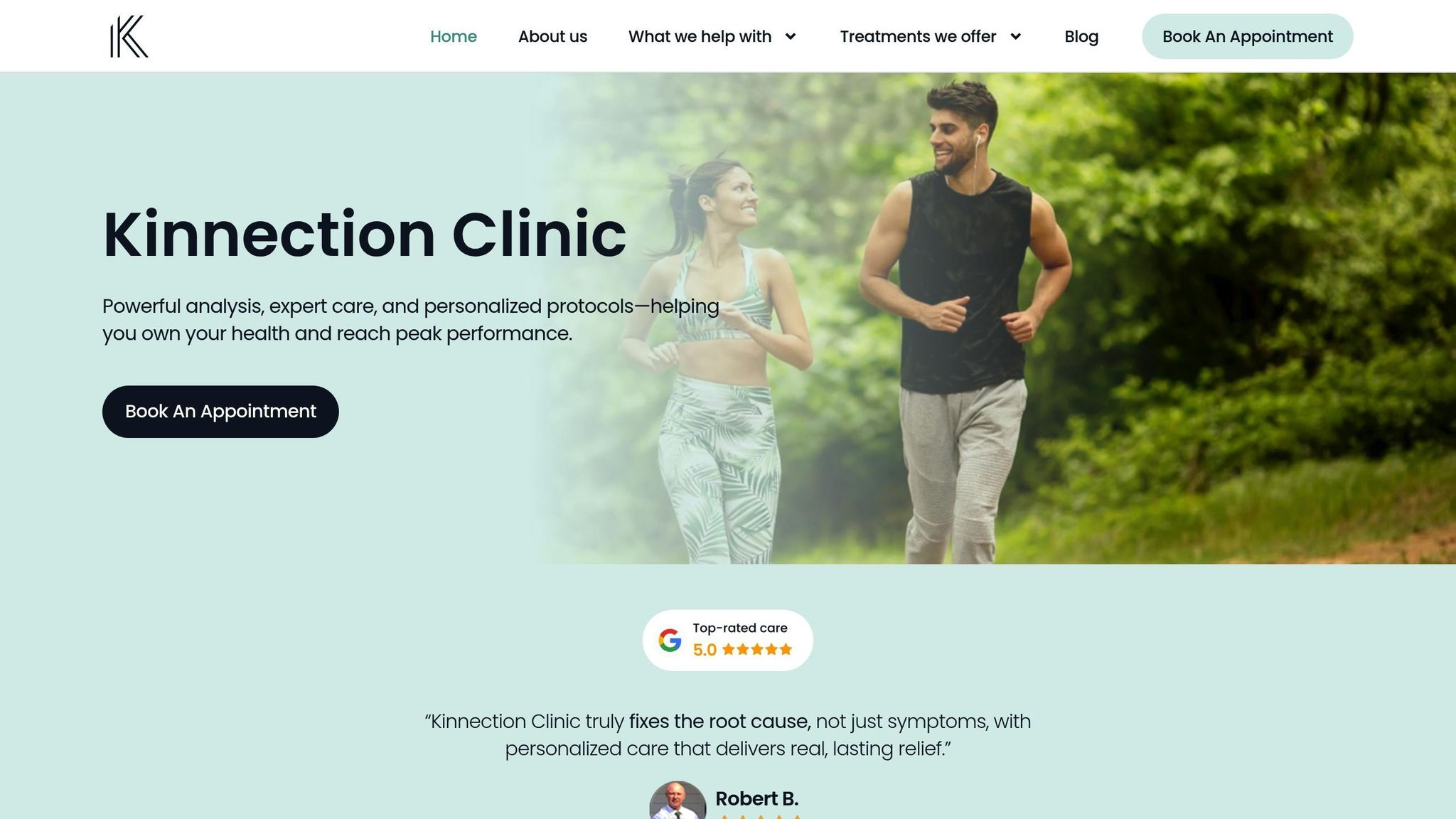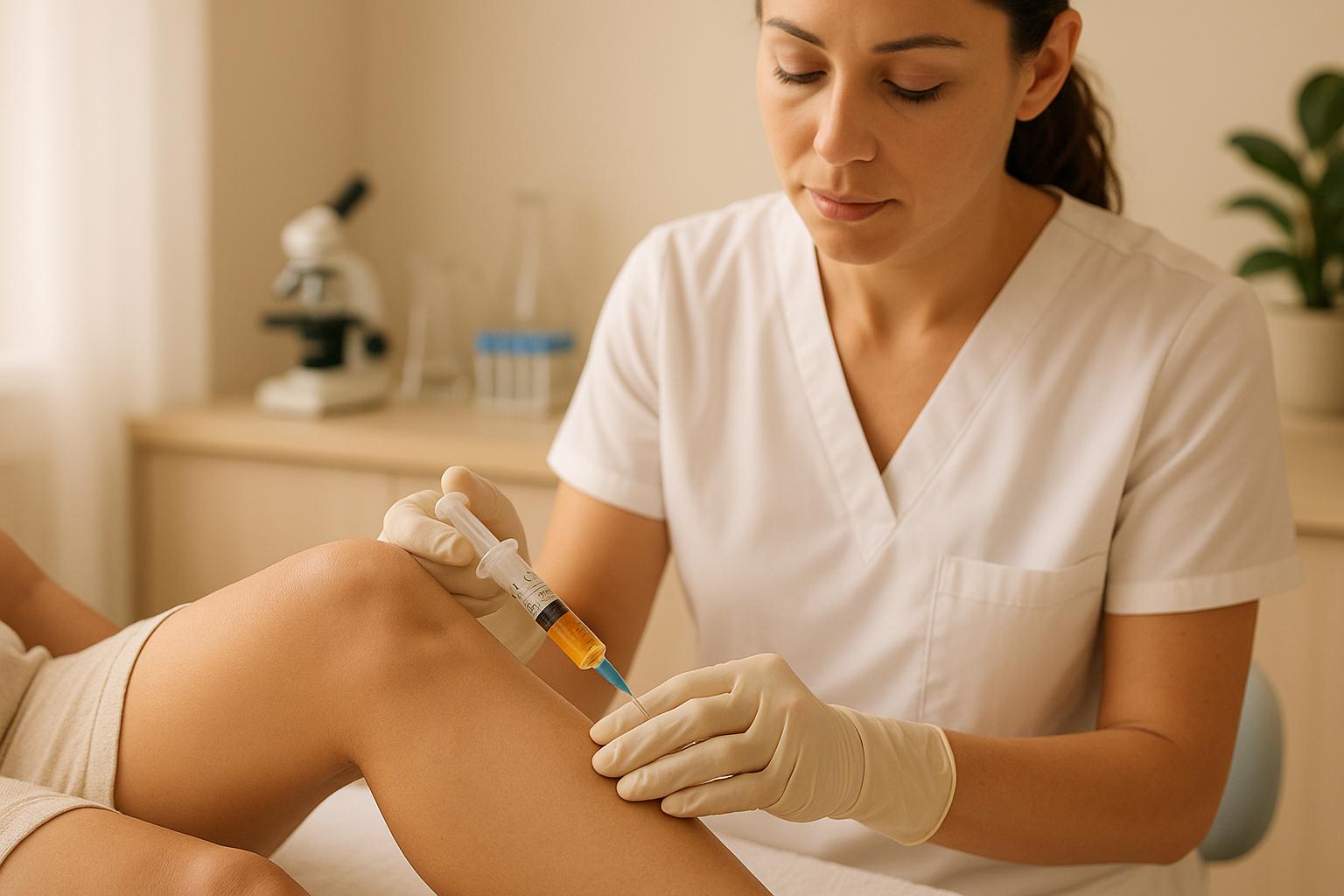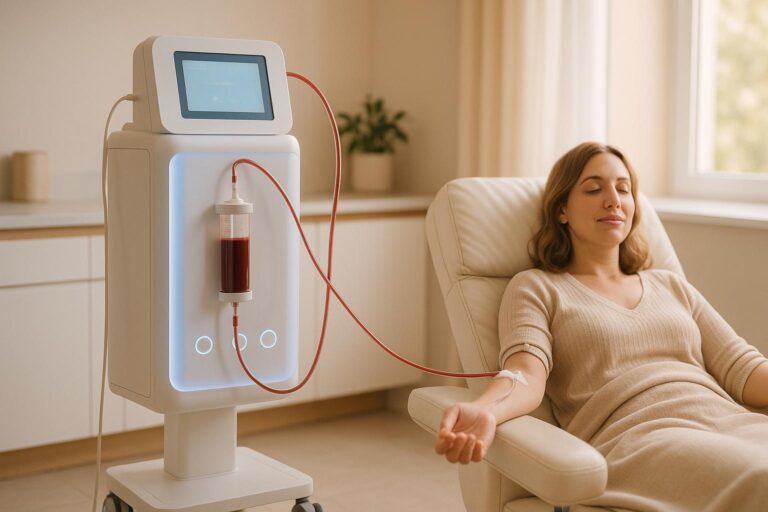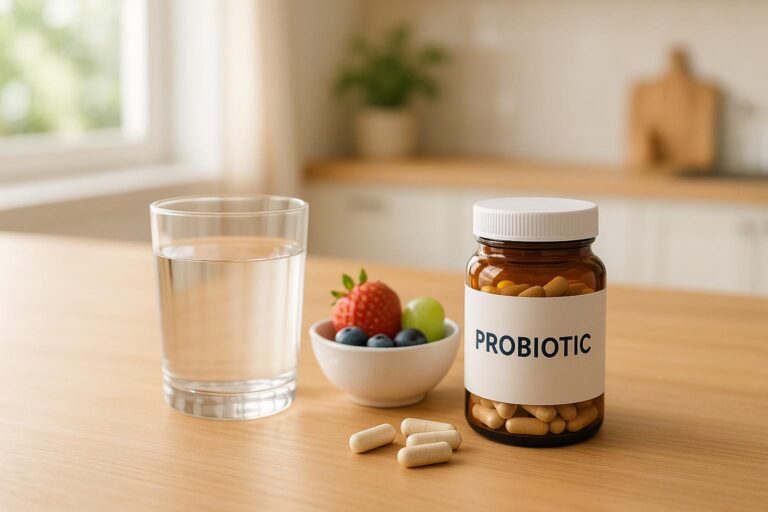Platelet-rich plasma (PRP) therapy is a cutting-edge option for managing chronic pain by promoting the body’s natural healing processes. Unlike medications that only mask symptoms, PRP targets the root cause of pain by repairing damaged tissues, reducing inflammation, and encouraging cell regeneration.
Here’s how it works:
- PRP uses your own blood: A small sample is drawn, processed to concentrate platelets, and injected into the affected area.
- Platelets release growth factors: These compounds stimulate tissue repair, improve blood flow, and reduce inflammation.
- Results develop over time: Pain relief typically begins within 2–6 weeks and improves further over 3–6 months.
PRP has shown promise in treating conditions like arthritis, tendon injuries, and ligament sprains. It offers a safer alternative to opioids and corticosteroids, with fewer risks and longer-lasting benefits. At Kinnection Clinic, PRP is part of a personalized care plan that addresses pain at its source, combining advanced diagnostics, functional medicine, and supportive therapies for better outcomes.
For those seeking relief from chronic pain without surgery or long-term medication, PRP therapy could be the solution.
How Platelet-Rich Plasma Helps to Heal Chronic Pain | PRP Injection Demonstration
How PRP Therapy Works
PRP therapy enhances your body’s ability to heal itself by concentrating platelets and delivering them directly to areas that need repair.
How Platelets Aid Healing
Platelets act like tiny repair kits within your body, carrying more than 30 growth factors and proteins that play a key role in healing. When activated, these platelets release substances that work together to rebuild damaged tissue.
The growth factors in platelets have several jobs when it comes to recovery and pain relief. For instance, Platelet-Derived Growth Factor (PDGF) helps form new blood vessels, ensuring injured tissues get the oxygen and nutrients they need to heal. Meanwhile, Transforming Growth Factor-Beta (TGF-β) encourages collagen production, which strengthens and supports tendons, ligaments, and cartilage.
One of the most important benefits for those dealing with chronic pain is how platelets help reduce excessive inflammation. While some inflammation is necessary for healing, too much can prolong pain and slow down recovery. PRP therapy helps shift this process, promoting a healing response instead of a harmful one.
Additionally, PRP stimulates stem cell activation and recruitment. Stem cells, which can develop into different types of tissue, often remain inactive in areas with chronic injuries. PRP essentially "wakes them up", encouraging them to repair damaged ligaments, tendons, cartilage, and other tissues.
How PRP Is Prepared
The process of creating PRP happens right in the medical office. A small blood sample (about 1 to 2 ounces) is taken and spun in a centrifuge for 10 to 15 minutes. This process separates the blood into layers, concentrating the platelets in a middle layer. The result is a solution with 3 to 5 times the normal platelet levels.
The concentrated platelet layer is carefully removed, creating a golden-colored plasma packed with healing factors. From blood draw to injection-ready PRP, the entire process typically takes about 30 minutes.
Different centrifuge systems may produce varying platelet concentrations, and the preparation can be adjusted depending on the condition being treated. Some systems even include white blood cells, which may offer added anti-inflammatory benefits for certain injuries.
Once prepared, the PRP solution is ready to reduce pain and repair tissue damage.
How PRP Eases Pain
PRP tackles pain at its source by promoting tissue repair through several mechanisms that address both symptoms and the underlying issues.
By calming inflammation, PRP helps reduce nerve sensitivity and encourages healing. The process begins within days and can continue for weeks.
As new tissue grows and damaged structures repair themselves, the root causes of pain – like strained or torn tendons – start to improve. For example, in tendon injuries, PRP stimulates the creation of new, healthier tendon fibers that are stronger and more flexible than scar tissue. This improved tissue quality reduces strain and prevents micro-tears, which are often the source of persistent pain.
PRP may also have a direct impact on nerve healing. Some studies suggest that the growth factors in PRP can help repair damaged nerves and reduce hypersensitivity, a common issue in chronic pain conditions. This can lead to lasting improvements in how pain is perceived.
Pain relief timelines vary from person to person and depend on the condition being treated. Many people notice improvements within 2 to 6 weeks, while maximum benefits often develop over 3 to 6 months as the tissue continues to regenerate. Unlike treatments that only mask symptoms, PRP therapy delivers lasting relief by addressing the actual tissue damage.
Chronic Pain Conditions Treated with PRP
PRP therapy has shown promise in addressing chronic pain, particularly when conventional treatments fall short. Chronic pain – defined as pain lasting three months or more – affects over 20% of adults in the United States.
Common Conditions Treated
Osteoarthritis: PRP is often used to manage osteoarthritis, a condition characterized by cartilage breakdown and inflammation. The growth factors in PRP help repair cartilage and reduce inflammation. The knee joint tends to respond particularly well, though other joints can also benefit from this approach.
Tendon Injuries: Chronic tendon issues, such as tennis elbow, golfer’s elbow, and Achilles tendonitis, result from tendons failing to heal properly after repeated strain. PRP injections work by regenerating tendon fibers, creating tissue that is stronger and more flexible.
Ligament Sprains: Lingering joint instability and discomfort from partially healed ligament sprains can also be addressed with PRP. This therapy promotes the formation of healthy collagen, strengthening ligaments and improving joint stability.
PRP is also being investigated for certain spinal conditions. Early studies on lumbar facet joint syndrome suggest that it may help repair tissue in spinal regions, reducing inflammation and alleviating back pain.
Results You Can Expect
The results of PRP therapy can be impressive. For example, studies show a 44.7% improvement in Western Ontario and McMaster Universities Osteoarthritis Index (WOMAC) scores for knee osteoarthritis after PRP treatment, compared to just 12.6% improvement with hyaluronic acid injections.
Patients often start noticing pain relief within 4–6 weeks, with maximum benefits typically seen between 6–12 weeks. PRP works by repairing damaged tissues, which not only reduces pain but also improves mobility and overall quality of life. Many patients report better sleep, increased energy, and the ability to return to work, hobbies, and family activities without constant discomfort.
The effects of PRP therapy can last for six months to a year or even longer. Some patients continue to see improvement for several months after their injection. Outcomes vary depending on factors like the specific condition being treated, the severity of the injury, overall health, and how well patients follow post-treatment care guidelines. While some individuals achieve excellent results with a single treatment, others may benefit from multiple injections spaced out over several weeks.
What Happens During PRP Treatment
PRP treatment typically takes about 60 to 90 minutes, with much of the time dedicated to preparing the concentrated platelets.
Patient Evaluation and Screening
Before undergoing PRP therapy, your doctor will conduct a detailed evaluation to determine if the treatment is suitable for you. This process involves reviewing your medical history, current medications, and the specific condition causing your pain. Medications such as blood thinners, NSAIDs, and systemic steroids may need to be temporarily paused to maximize the treatment’s effectiveness. Your doctor will also examine the affected area, discuss your pain levels and mobility challenges, and review any prior treatments. In some cases, imaging studies like X-rays or MRIs might be ordered to better assess the extent of tissue damage.
To prepare for the procedure, you’ll need to stay hydrated, eat a nutritious breakfast, and avoid alcohol and smoking for several days beforehand. Once cleared, the treatment moves forward with a straightforward injection process.
The PRP Injection Process
The process begins with a simple blood draw, much like routine lab work. Around 30 to 60 milliliters of blood is collected from your arm and immediately processed on-site to concentrate the platelets by five to ten times their normal amount.
After the PRP is prepared, the injection site is cleaned and numbed to minimize discomfort. In many cases, ultrasound guidance is used to ensure the PRP is injected precisely into the target area. The injection itself only takes a few minutes. While you may feel some pressure or mild discomfort, the numbing agent helps keep it manageable. For more extensive injuries, multiple injection sites may be treated during the session.
Safety and Recovery Time
PRP therapy is considered very safe since it uses your own blood, which minimizes the risk of allergic reactions or disease transmission. Medical facilities follow strict sterility protocols during the preparation process to avoid contamination.
"Because the treatments use a patient’s own tissues, PRP injections are safe and can be administered alone or used in conjunction with other procedures." – Johns Hopkins Medicine
After the injection, you might experience mild pain, redness, or swelling, which usually fades within a few days. These symptoms are a sign that the healing process has begun. Applying a cold compress for 10 to 15 minutes several times a day can help ease any discomfort.
Recovery times vary based on the condition being treated:
| Condition Type | Recovery Timeline | Restrictions |
|---|---|---|
| Mild to Moderate Musculoskeletal Injuries | 4–8 months | Avoid stressing the injured area; gradually increase activity after 4 weeks |
| Moderate to Severe Musculoskeletal Injuries | 6–12 months | Follow your doctor’s instructions; physical therapy may begin after 5 weeks |
Most patients can return to normal daily activities within 24 hours. However, strenuous exercise should be avoided for the first day, and intense workouts are best delayed for at least two weeks. Anti-inflammatory medications should also be avoided for at least four weeks, as they can interfere with the healing process.
Additional post-treatment guidelines include refraining from alcohol for 24 hours to three days, avoiding smoking, and steering clear of applying ice or heat to the injection site for the first 72 hours. These steps help ensure your body fully benefits from the concentrated growth factors delivered through the PRP injection.
sbb-itb-d9e542d
PRP Therapy Results and Limitations
PRP therapy has gained attention for its potential to address chronic pain conditions, but understanding its benefits and limitations is essential for setting realistic expectations.
Research on PRP Effectiveness
Clinical studies suggest that PRP therapy holds potential, though results can vary depending on the condition and how studies are conducted. For instance, research on osteoarthritis, particularly in the knee, indicates that PRP can provide pain relief lasting several months. In some cases, it appears to offer longer-lasting benefits compared to traditional corticosteroid injections.
Tendon injuries also show promise with PRP treatment. Studies on conditions like chronic tennis elbow, Achilles tendinopathy, and rotator cuff injuries have reported noticeable pain reduction within a few months after treatment.
However, outcomes depend on several factors, including the quality of studies, how PRP is prepared, and the timing and frequency of treatments. Researchers are still working to identify the most effective protocols.
Factors That Affect Results
The effectiveness of PRP therapy can vary based on several factors:
- Patient characteristics: Younger individuals and those in good overall health often see better results. In contrast, advanced degenerative conditions may lower the chances of success.
- Post-treatment care: Following recovery guidelines, like gradually resuming physical activity, can make a big difference in outcomes.
- Health and lifestyle considerations: Conditions like diabetes or autoimmune disorders, as well as habits such as smoking, can impact the body’s ability to heal and may affect the success of PRP therapy.
When PRP May Not Work
PRP therapy isn’t a one-size-fits-all solution. It’s less effective for advanced degenerative changes, such as severe cartilage loss or significant structural damage, where tissue regeneration may not be sufficient. Similarly, systemic inflammatory conditions like rheumatoid arthritis or lupus can limit its effectiveness.
Patients on blood thinners or those with bleeding disorders may not be suitable candidates, as PRP relies on the body’s normal clotting mechanisms. Additionally, some individuals may experience little or no improvement, highlighting the variability in how people respond to the treatment.
It’s also worth noting that PRP improvements take time – results usually develop gradually over several months rather than immediately. On top of that, insurance coverage for PRP therapy in the U.S. is often limited, which may be a consideration for some patients.
PRP Therapy at Kinnection Clinic

Kinnection Clinic takes the well-known benefits of PRP therapy and builds on them with a comprehensive, patient-focused approach. Here, PRP therapy is just one part of a broader strategy aimed at addressing the root causes of chronic pain. By combining advanced diagnostic tools with tailored treatment plans, the clinic helps patients unlock their body’s natural healing potential.
PRP therapy is integrated into a larger regenerative medicine program that includes treatments like peptide therapy and tissue regeneration techniques. Together, these methods target structural damage, inflammation, and other systemic issues that may be slowing recovery.
Comprehensive Regenerative Care
At Kinnection Clinic, PRP therapy is paired with functional medicine evaluations to uncover factors like nutritional deficiencies, hormonal imbalances, or inflammation that may hinder healing. This holistic approach ensures that every aspect of the patient’s health is considered.
For example, lab tests might check for vitamin D levels, omega-3 deficiencies, or elevated inflammatory markers. If any issues are identified, the clinic offers targeted solutions, such as customized nutritional advice or IV therapy, to create the best possible conditions for healing before and after PRP treatments.
The clinic also incorporates Gonstead chiropractic care, which can improve nerve function and blood flow, making PRP therapy even more effective. Chiropractic adjustments are often included in treatment plans to enhance overall biomechanical function.
For patients whose pain may be linked to age-related hormonal changes, hormone replacement therapy may be recommended. Balanced hormone levels are crucial for tissue repair and regeneration, making this an important part of some patients’ recovery journeys.
This integrative approach ensures that each treatment plan is designed specifically for the individual, addressing their unique needs and challenges.
Personalized Treatment Plans
Kinnection Clinic customizes every aspect of care to maximize the regenerative potential of PRP therapy. Each patient begins with a thorough diagnostic process, which may include digital X-rays and advanced lab testing. This helps create a detailed understanding of their health and the factors contributing to their condition.
Treatment plans are not just about alleviating pain – they aim to tackle the underlying issues that prevent natural healing. These plans might include detoxification protocols to reduce inflammation, tailored nutritional advice to support tissue repair, or performance coaching to encourage sustainable lifestyle changes.
Recovery plans are adjusted based on the patient’s specific injuries, health challenges, and progress. The clinic provides regular monitoring and makes modifications as needed to ensure the best possible outcomes.
Beyond physical treatments, patients receive ongoing support in the form of performance coaching and mindset training. This comprehensive approach acknowledges the psychological aspects of chronic pain, addressing mental health and resilience alongside physical recovery for more effective, long-lasting results.
Conclusion
PRP therapy provides a promising option for managing chronic pain by tapping into your body’s own healing abilities. By concentrating platelets, this treatment helps repair damaged tissue, ease inflammation, and support long-term recovery.
The science behind PRP is straightforward yet powerful – platelets release compounds that speed up cell regeneration and improve blood flow to injured areas. This makes it especially helpful for conditions like arthritis, tendon injuries, and joint pain, which are often tough to address without surgery or ongoing medication.
At Kinnection Clinic, PRP therapy is more than just a standalone treatment. It’s part of a broader regenerative care program that combines personalized functional medicine, Gonstead chiropractic care, and hormone optimization. This integrated approach ensures all aspects of your health are considered, targeting the root causes of pain rather than just masking symptoms.
"Kinnection Clinic truly fixes the root cause, not just symptoms, with personalized care that delivers real, lasting relief." – Robert B.
With a team of specialists in regenerative and functional medicine, Kinnection Clinic develops tailored plans that go beyond the PRP procedure, focusing on comprehensive and evidence-based care.
For those dealing with chronic pain, PRP therapy at Kinnection Clinic offers a minimally invasive alternative with quicker recovery times. By addressing underlying health factors and encouraging your body’s natural healing processes, it provides a path to genuine relief – no surgery or lifelong medications required. Many patients experience the freedom they’ve been searching for, thanks to this holistic and science-backed approach.
FAQs
How is PRP therapy different from treatments like opioids or corticosteroids for managing pain?
PRP therapy takes a different path compared to traditional pain treatments like opioids or corticosteroids, focusing on healing the root cause rather than just masking symptoms. Opioids, for instance, block pain signals but come with serious risks like dependency. Corticosteroids, on the other hand, may provide temporary relief but can lead to side effects with repeated use.
What sets PRP apart is its use of your body’s own platelets to encourage natural tissue repair and regeneration. Instead of offering a quick fix, this method targets the underlying causes of pain, aiming for longer-lasting relief. By activating the body’s natural healing processes, PRP therapy provides a safer alternative without the risks tied to more conventional treatments.
What chronic pain conditions can PRP therapy help with?
PRP therapy is a go-to option for dealing with chronic musculoskeletal pain. It’s often used to treat conditions like tendinitis (such as tennis elbow or rotator cuff tendinitis), plantar fasciitis, and osteoarthritis in areas like the knee, hip, or shoulder. It’s also helpful for easing joint pain, arthritis, and injuries involving microtears or wear-and-tear issues.
This therapy works by tapping into your body’s own platelets to encourage tissue repair and calm inflammation. The result? A natural way to achieve lasting pain relief and better mobility for these types of conditions.
What is the recovery process like after PRP therapy?
Recovery after PRP therapy is usually simple, with little downtime. You might notice some mild bruising or swelling in the treated area, which typically lasts about 1–2 weeks. While most people can return to light activities during this period, full healing – especially for injuries – can take anywhere from 3 to 6 months.
To aid your recovery, it’s crucial to rest the treated area for 24–72 hours and steer clear of intense physical activities. Make sure to follow any personalized care instructions provided by your healthcare provider. These steps can play a big role in supporting your healing process and achieving the best results.



